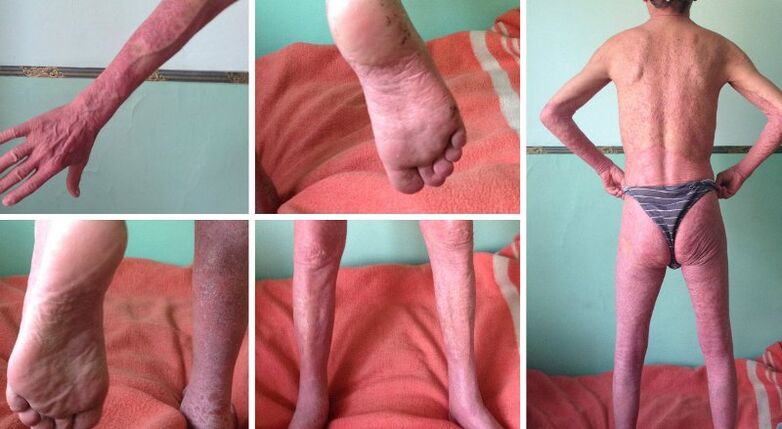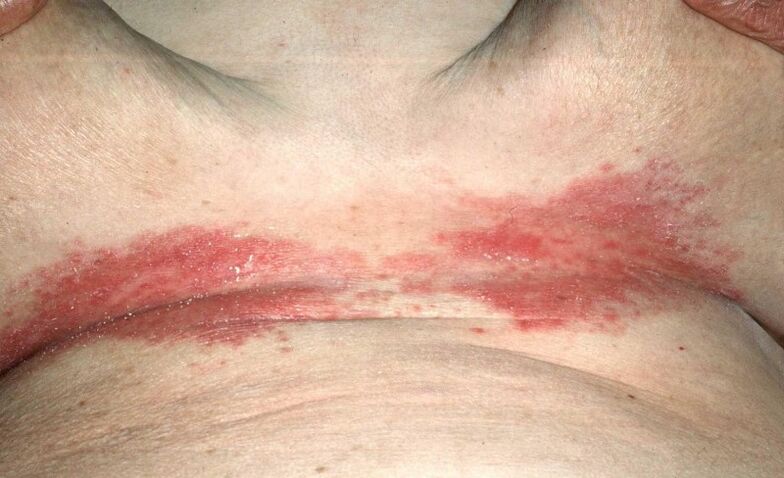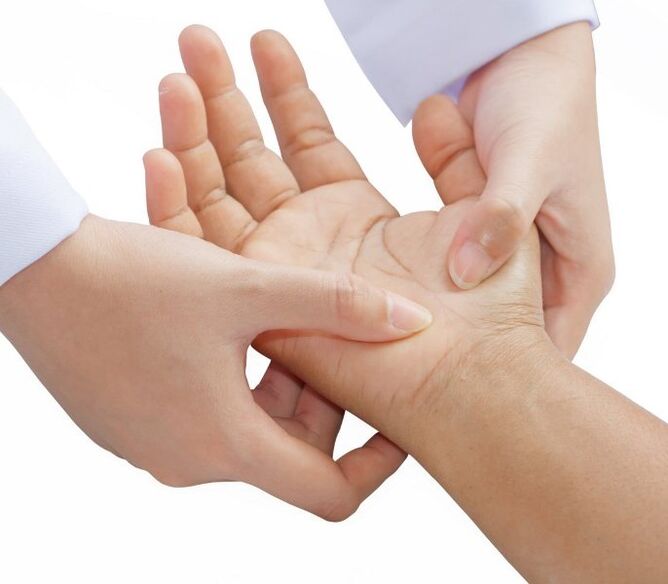Psoriasis is a common skin disease of neurogenic etiology. The disease is not contagious and it is not transmitted from person to person. Most often, due to its latent course, psoriasis becomes chronic. Usually the disease develops in people under the age of 30, but it can also appear in old age.
External symptoms may be absent, the clinical picture of the disease depends on the type and stage. Most often, psoriasis begins with the appearance of bright red spots, covered with dry scales, therefore the disease has a second name - squamous cell pore.
Patches of skin can vary in size, some can bond to an affected area of skin and protrude significantly above the surface.
Psoriasis causes physical and mental discomfort in the patient, the disease periodically worsens, in between a period of remission occurs and the symptoms subside.
Patches of skin are called psoriatic plaques or papules, most often they affect the elbows and knees, spread to the head and lumbar region. Depending on the type of disease, plaques can also affect other parts of the body. Treatment can last longer than a year.
Causes of the onset of the disease

Psoriasis causes several causes associated with various factors, both external and internal:
- a common cause is genetic inheritance;
- the disease can develop due to constant stress, anxiety, shock, depression and mental disorders;
- various autoimmune diseases and a malfunction of the immune system create ideal conditions for the outbreak of the disease on the surface of the skin;
- Chronic psoriasis can also cause metabolic disorders, as well as a malfunction of the endocrine system.
The type of psoriasis and its course depend on the etiology of the disease.
Classification of psoriasis

The disease has several forms, on which the external manifestation and symptoms depend:
- The most common form of the disease is psoriasis. The surface of the skin is covered with red or pink spots covered with scales. They are in stark contrast to healthy skin, are denser and raised above the surface below. The cuticle is easy to remove and starts to bleed if it is disturbed, causing severe itching and burning. As the disease worsens, the spots can grow and fuse together, creating large areas of damage.
- Guttate psoriasis looks different, the spots may be pink or purple, during the exacerbation they become lighter. The scales can be larger and look like droplets, they can also merge into large areas.
- Another form of psoriasis that only affects the places of wrinkles and folds of the skin - elbows, armpits, areas under the folds of fat on the abdomen or chest, in the groin. The spots are smooth, even, do not itch and have no scales. If there is friction with the clothing in the affected areas, the surface of the stains can easily be damaged.
- The chronic form of nail psoriasis is also common, mainly affecting the nail plate on the fingers or toes. Nails lose their shape, deform and discolor. The nails begin to thicken and peel off, the disease can provoke the loss of the nail plate. In the initial stages, nail psoriasis is easily mistaken for a fungal infection, so you need to see a doctor for diagnosis and proper treatment.
- The most severe form of the disease is pustular, characterized by the appearance of blisters filled with light-colored liquid that can be easily broken by rubbing clothes. When pustules are destroyed, pus forms in them and secondary skin infection occurs. This form of psoriasis is dangerous because it can cover almost the entire body, making it difficult to progress.
- Rheumatoid psoriasis affects not only the surface of the skin, but also joints and periarticular soft tissues. This mainly affects the knee, shoulder and hip joints. Lesions are expressed not only by external symptoms, but also by pain in the joint, which brings additional suffering to the patient. When the hands or feet are affected, swelling of the fingers is observed, their sensitivity decreases, and deformation begins. In the most severe and neglected form, the patient can lose limb sensitivity and become disabled.
All of these forms can progress on their own or they can occur together, it all depends on the severity of the disease.
Stages of psoriasis

The chronic form of the disease has different stages, each of which has its own symptoms and characteristics:
- as the stage progresses, spots covered with scales quickly appear and increase in size. They are usually red in color, but can change color depending on the form of the disease. The skin in these places is very itchy, burning and painful;
- at a stable stage, the disease does not cause painful sensations, it flows measured, the scales gradually grow, they can periodically merge;
- with a regressive stage, papules can resolve on their own, they do not cause any concern other than external signs.
Psoriasis is a chronic condition that alternates between exacerbation and remission.
Reasons for the exacerbation

Worsening of the disease can have many causes, both external and internal:
- prolonged exposure to cold with frostbite of the skin;
- violation of the hormonal background of the body during puberty, pregnancy or menopause;
- Long-term therapy with certain drugs (antibiotics), self-medication, violation of the dosage when taking complex vitamins and herbal dietary supplements;
- the disease can be exacerbated by climate change or exposure to the sun;
- alcohol abuse can not only aggravate the disease, but also complicate its course;
- Traumas, burns, frostbite, and other mechanical damage to the skin always cause psoriasis to worsen;
- Infection with viruses and bacteria can cause an outbreak of disease, sometimes common respiratory disease causes skin diseases to worsen.
The rheumatoid form of psoriasis has a seasonal exacerbation:
- in summer - when you are in the sun;
- in winter - due to hypothermia.
The ultraviolet radiation helps the papules heal, but the sun's infrared rays irritate the skin.
Psoriasis is diagnosed with little difficulty, the disease has vivid symptoms, additional studies in the form of a blood test and skin biopsy are done to rule out other diseases.
treatment

Medicine today has made great strides in the treatment of skin diseases, including psoriasis; there are several methods that can be used to treat an advanced form of the disease. The doctor determines the method of treatment on a purely individual basis, based on the form, stage, causes and symptoms. The treatment is always comprehensive and combines drug therapy and physical therapy.
Drug treatment includes the use of both internal and external drugs:
- to eliminate skin pathologies, ointments based on salicylic acid, sulfur, dithranol and urea are used;
- Glucocorticoid ointments;
- Lotions for the treatment of the scalp.
At the stage of exacerbation, hormonal ointments are used to eliminate the inflammatory process, treatment is always started with less strong ones. If the disease progresses again, use strong fluoridated agents. They are used for two weeks to get the result.
For the elderly and children, ointments are used with the slightest side effects.
With an increase in the dosage, ointments based on dithranol are prescribed to get rid of the inflammatory process, itching and swelling.
Preparation with kAlcipotriolhas a direct medicinal effect on pathogenetic provoking factors. It has anti-inflammatory and immunomodulatory effects. Usually, a treatment has a noticeably positive result in two months, the rash may go away completely. This remedy has no side effect in the form of skin atrophy and has a lasting effect. The medicine is used to treat a teardrop-shaped form of psoriasis that is difficult to treat.
All medication must be alternated, otherwise it can lead to dependence and the body no longer reacts to it.
Treatment with aromatic retinoids is also considered effective.
In addition to drug therapy, a number of requirements must be met for successful treatment:
- follow a dietary diet;
- take the necessary vitamins under medical supervision;
- avoid stressful situations, in case of a depressed state, you need to consult a doctor to prescribe the necessary funds;
- protect the affected areas as much as possible from contact with chemicals, especially hands and nails;
- wear only cotton clothing so as not to cause additional skin irritation;
- do not consume alcoholic beverages and confectionery, and contact with allergens should also be avoided.
If all recommendations and rules of treatment are followed, then remission of the disease and, in some cases, complete cure is possible.

























